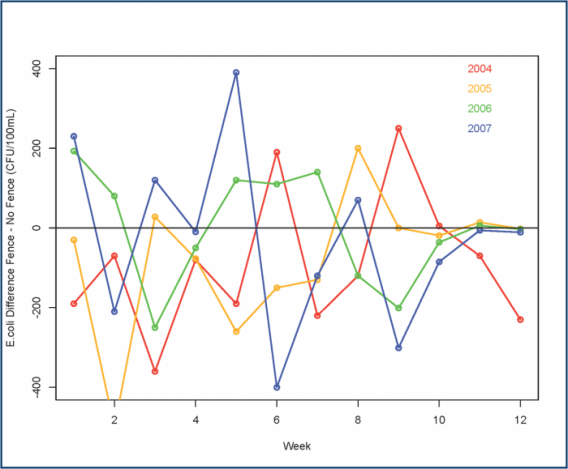Conclusions

While the statistical
analysis of the project data presented a valid result, on the basis of
the data meeting the assumptions of the statistical test
applied, the presented results are of limited value because of
flaws in experimental design. Because water is a flowing medium,
land uses and cattle presence upstream contribute E.coli to water
sampled from the treatment area. The location of the treatment
(fencing) site downstream of the control/background site (upstream)
presents a difficulty because the water quality observed at the fencing
treatment represents the cumulative E.coli load of both the upstream
area where cattle have access to the channel and the treatment reach
where cattle have no access. The proximity, small size and
relative locations of the fencing treatment area and
background/unfenced area indicate that the two treatments are
not truly independent of one another.
Independence is a fundamental requirement for inferential
statistics; as such, the comparison of E.coli means using a t test is
not valid.
To see a difference in the mean E.coli between the
background level and that following the stream's passage through the
fencing treatment area, the length of treatment reach would need to be
adequate to allow natural attenuation of E.coli, or the treatment reach
would need to have some biological function capable of reducing
E.coli. The predicted effect of the fencing treatment is to
limit direct E.coli deposition directly to the stream, not to modify
instream habitat. The length of the treatment reach, 800 m, given
flow conditions, is likely not long enough to remove the effect of
E.coli entering the treatment area from
upstream. Additionally, the fenced treatment is unreplicated
in both space and within each temporal period, so I would be
unable to expand any findings to a broader population (i.e., beyond the
one study stream to agricultural watercourses in southern Alberta or to
other years).
No uniform effect on E.coli concentration was
observed with the fencing treatment from week to week. As can
be seen in Figure 15, from week to week throughout the study
period, E.coli concentrations shifted from a positive
difference between treatments (suggesting an increase in E.coli
after fencing) to a negative difference (suggesting a decrease in
E.coli after fencing).
Figure 15. Confounded treatment effects visible in comparison of weekly differences in E.coli between fenced and non-fenced sites, 2004 to 2007. Positive differences indicate an increase in E.coli concentration after the fencing treatment is applied, while negative differences indicate a decrease in E.coli concentration after the fencing treatment.
The original question,
does exclusion fencing reduce E.coli concentrations in streams,
cannot be adequately answered by this research program because of these
flaws in experimental design. No significant difference (a=0.05)
was observed between mean log E.coli concentrations of the fenced and
unfenced treatments for 2004 to 2007, but I cannot infer
any conclusion regarding the efficacy of the fencing
treatment at reducing E.coli in streams. The lack of
independence between the treatments invalidates any
inferential statistical analysis.
Benefits to future study of
the research watercourse and watershed may be drawn from the this work
through the decriptive analysis of natural variation of water quality
(in this case, E.coli concentrations) within the channel.
Understanding seasonal and annual variation in water quality from
2004 to 2007 forms a baseline for future comparisons of
impacts of landscape or climate changes and supports further, more
rigorously designed, experimentation to study the effects of
agricultural land use changes.



